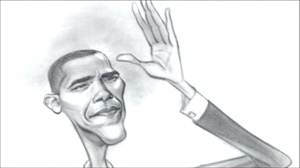Caricatures of the Presidential Candidates
 An example of how cartoonists embed sophisticated ideas inside their drawings, videos from the Washington Post of caricaturist John Kascht describing his process. I especially liked the idea of Obama not smiling (in spite of the positive persona the campaign has been selling), and the description of McCain’s head as a “clenched fist” couldn’t be more apt. These are impressions that will stick with me next time I see all these candidates.
An example of how cartoonists embed sophisticated ideas inside their drawings, videos from the Washington Post of caricaturist John Kascht describing his process. I especially liked the idea of Obama not smiling (in spite of the positive persona the campaign has been selling), and the description of McCain’s head as a “clenched fist” couldn’t be more apt. These are impressions that will stick with me next time I see all these candidates.
On Obama: “There’s a messianic aura about him. … That air of destiny really registers all across his face and in his body language as well. He shines. Light literally bounces off the guy from everywhere … And yet for all of the surface appeal of him, I’m drawn to the unsmiling images of him, where he has his head tipped back with an almost aristocratic bearing. Seems very telling somehow. As a work in progress he’s completely fascinating to watch and to draw.”
On Hillary: “It seems to fit that Clinton’s cheeks are her most prominent features. Cheeks aren’t exactly the windows to the soul, but Hillary Clinton’s not exactly a ‘peek inside my soul’ kind of person, anyway. … Her round facial features seem to balance on top of one another, and along the same lines her head seems to balance on top of her narrow shoulders like a boulder on a pyramid. I find it really interesting that this graphic profile that she cuts—of all of these elements in precarious alignment—is such a perfect metaphor for her political balancing act.”
On McCain: “His jaw gives him away…it’s an anger barometer. During debates when he’s being challenged by an opponent, he bites down hard, and you know what he really wants to do is go to the podium next door and smack somebody. … He’s got a head like a clenched fist, and it expands with every passing year. … His small, dark eyes are watchful and wary. Whether he’s smiling or talking he bares his teeth; they’re choppers really, and they flash with metal. They look like weapons. His skin isn’t skin so much as hide.”
On Mitt: “Mitt Romney is both the easiest and the hardest of the candidates to caricature. … He seems less like an individual person than a ‘type’ of person. He’s what central casting might come up with for the game show host type or the Ward Cleaverish 50’s dad type. … Because of the heavy ridge of his brow and his deep-set eyes, it’s tough to even see his eyes, much less find a twinkle in them. But his hair sparkles. That’s what we end up making eye contact with. It’s off-putting rather than inviting.”
Link and summaries stolen from Daily Kos.

